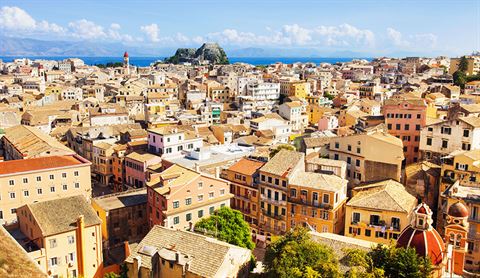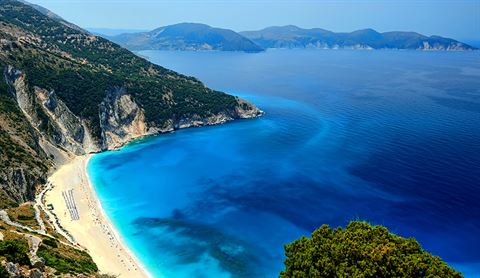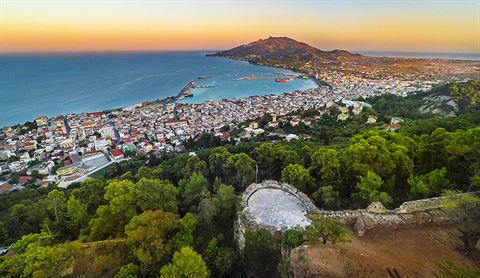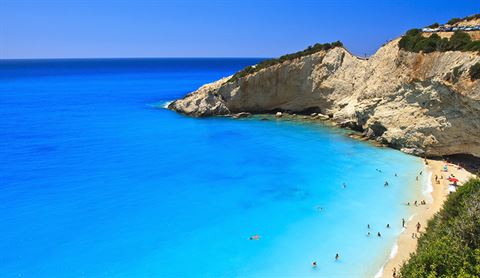ADVERTORIAL • October 2021
A Member’s guide to the Greek islands
From screensaver-worthy beaches and secluded coves to cypress-lined valleys and ancient villages, Greece’s Ionian islands share a timeless natural beauty. If you’re ready to step away from your daily grind and onto a plane, here’s where you’ll want to land…

Corfu
What for: the romantic affair
Successive invasions by the Venetians, French and British all left their architectural mark on Corfu over the centuries, and the pervading echoes of Italianate romance, in particular – with some streets that feel more in the vein of Venice or Genoa – combine to spectacular effect. Beyond Corfu’s celebrated beaches – if you’re a fan of sailing culture, this is the island for you – landmarks that visitors would do well not to skip include the photogenic promenade of Liston, which is lined with the inviting outdoor tables of smart local coffee shops. Nearby, the Spianada is the largest public square in Greece.
Top tip: If time allows, walk the Corfu Trail, a popular route through the surprisingly diverse natural landscapes of the island, which brings you to inland areas of outstandingly beautiful natural scenery that you might never have otherwise found.

Kefalonia
What for: sea turtles and wild horses
Whether or not you’ve read Captain Corelli's Mandolin or seen the 2001 film (which was made here), one look at Kefalonia and you’re in no doubt as to why its landscapes translate so well onto the big screen. Snorkel or dive in the startlingly clear waters off this largest of all the Ionian islands, and you might be lucky enough to find yourself in the company of a rare loggerhead sea turtle. Divert from paradisiacal beaches to enjoy drives or hikes through the island’s verdant mountain landscapes, or make some ‘research’ trips to the vineyards.
Top tip: Also on Kefalonia is the vast, forested Mount Ainos: the only National Park on a Greek island where semi-wild horses roam. Or take a boat ride out to see the stalagmites of Lake Melissani.

Zakynthos
What for: flower bursts and secluded coves
Once called the 'Fioro di Levante’, or ‘Flower of the East’, there are some 7,000 species of flower to be found on Zakynthos, and in spring and summer the island is punctuated by floral colour-bursts. The Greek myths include captivating origin stories for species such as the Narcissus and Hyacinth, but you might not have all that much time to stop and smell the roses (and the rest) if you’re making the most of the island’s varied 123km coastline – with its miles-long sandy beaches and gnarly, rugged cliffs.
Top tip: Navagio Beach, also known as ‘Shipwreck Beach’, is among the best-loved coves: a supermodel in a hyper-bright palette of turquoise and white. It’s only accessible by boat, passing under the spectacular natural arches of ruined sea caves.

Lefkada
What for: taking to the water
A flamingo-inhabited lagoon almost – but doesn’t quite – connect the island of Lefkada to mainland Greece. Visitors here typically fly to Preveza and then travel for an hour by road to reach this island, which feels almost magically removed from the stressors of modern life – think hillside monasteries and hidden waterfalls. Lefkada’s eponymous capital is a port town, laid out in a distinctive ‘fish backbone’ pattern, and is a pedestrian-friendly blend of public squares, mysterious alleyways and elaborate belfries.
Top tip: Before you leave, head to Porto Katsiki – named after its resident goats, who make swift work of cliff-face climbing – for a view across the island that you won’t forget in a hurry.
British Airways flies to 13 destinations within Greece. To plan your trip to the Greek islands today, click here
This article has been tagged Advertorial, Destination
More from previous issues

The flight diaries: what it’s like to fly right now
The joys of crossing the pond with two kids in tiger masks in tow

Five epic drives: Marek Reichman
Aston Martin’s chief creative officer relives some of his greatest road trips

The best gadgets for hybrid working
Seven bits of high-tech kit you’ll want for the new world of work

London’s best business hotels: reviewed by Members
We check in to some of the smartest spots for combining business and pleasure
